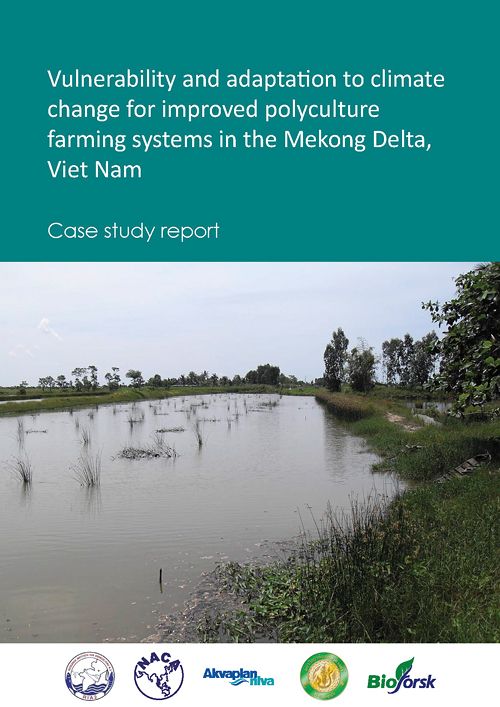Vulnerability and adaptation to climate change for polyculture systems, Vietnam
4 October 2012 | 986 Downloads | .pdf | 3.03 MB | Emerging Global Issues, Shrimp, Environment and Sustainability, Vietnam
The shrimp farming case study is conducted in Cà Mau and Bạc Liêu provinces, Mekong Delta, Southern Vietnam by: (1) organized stakeholder workshops to map farmer's perceptions, adaptation measures and agencies involved; and (2) questionnaire survey to assess vulnerability of the production system to climatic changes and extreme climatic events. Shrimp farming in the Mekong Delta is dominated by small-scale practices in terms of area and production. For example, Cà Mau province contributed about 20% of aquaculture shrimp to the total Mekong Delta and 15% of the nation, especially 91% of the production from the improved extensive model. Yield ranges 133.00 – 159.60kg/ha/season and profit estimated about 8.03 – 17.76 million Dong/ha/season.
Temperature, rainfall, sea level rise, storm and typhoon in the Mekong Delta are predicted to change substantially in the future. For example, sea level may rise about 28 – 33cm by 2050 and about 65 – 100cm by 2100 relative to the baseline period of 1980 – 1999. Local farmers have already observed irregular weather pattern and extreme events for the last decades. There are at least 11 climate change events observed by farmers. The farmers stated that most of climate change impacts have negative impacts (74.75%), 20.56% would have no consequence and 4.69% have positive impacts. Opportunity to diversify likelihoods into multi-cropping (rice crop in the wet season and shrimp in the dry season) is a typical positive impact from salt intrusion.
Farmer perceptions of climate change are identified: High temperature, Water level rise, Rainfall in the dry season, Storm and typhoon, and irregular seasonal change. Farmers stated that “High temperature” is the most important factors influencing their shrimp farming followed by “Storm and typhoon”, “Sea level rise”, and “Rainfall”. Meanwhile, group of Science and Technology claimed that “Rainfall” is the most important due to irregular and unusual weather, followed by “Storm and typhoon”, “High temperature”, and “Sea level rise”.
Adaptation measures are identified by farmers and have been adapted to climate change. For “High temperature”: change surface water, make pond deeper, increase dike height, make ditch wider; For “Storms and typhoons”: improved pond dike (wider and stronger), use probiotic to improve water quality, improve sluice gate; For “Sea level rise”: improved pond dike (wider and stronger), improve forecast information/ monitoring, use net to prevent shrimp escape, use water pumping machine; For “Rainfall”: use lime to adjust water quality, change water surface, use aerator.
Policy frameworks including the policy options are also recommended by Science and Technology Group, including applying Best Management Practices or aquaculture certifications, new pond design, seed quality control, accurate weather forecast, planting mangrove for coastal erosion protection, crop calendar management, planning and zoning for rice and shrimp culture, salinity tolerance species.
Actions plan to respond to climate change should undertake: (1) Training of farmers and trainers by regular training, posters, workshops, education, mass media and materials on policy/strategy; (2) More funding for improving infrastructure (dike and sluice gate maintenance) (24.3%) by establishing credit programmes and allocating a reasonable budget for related activities; (3) Need for standard routines for monitoring shrimp farms to monitor water/seed quality and inspect disease outbreaks and then inform/advise farmers in order for farmers; (4) Establishing shrimp cooperatives/clubs as co-management models to solve conflicts between farmers in water and management and disease infection; (5) Plan and zone for aquaculture at sustainable development by GIS tools and analysis; (6) Establish new farming models and improve pond design by intensify the farming system in a small area as a nursery area or intensive farming area; (7) Diversify livelihoods to improve farmers’ income and resilience capacity to climate change; (8) Enhance shrimp population in the wild by regularly release into the wild; (9) Good Aquaculture Practices should be encouraged for farmer communities; (10) Establish “New rural development model” as recently approved by the Central Government with the aim at supporting a group of local people in shrimp farming to improve household’s income and sustainable development.
Creative Commons Attribution.

